1. Early Life and Education
Santiago Calatrava's early life and extensive education laid the foundation for his unique approach to architecture and engineering, blending artistic sensibility with rigorous structural principles.
1.1. Childhood and Education
Santiago Calatrava Valls was born on 28 July 1951, in Benimàmet, a former municipality now part of Valencia, Spain. His surname, Calatrava, is an old aristocratic name associated with an order of knights from medieval Spain. From 1957, at the age of eight, he began studying drawing and painting at the School of Applied Art in Valencia. In 1964, as Spain's political climate liberalized, he participated in an exchange program in France. After completing secondary school in 1968, he briefly attended the École des Beaux-Arts in Paris, but student unrest prompted his return to Valencia.
Back in Valencia, Calatrava's discovery of a book on Le Corbusier's architecture profoundly influenced him, convincing him that he could integrate his artistic aspirations with a career in architecture. He enrolled in the Higher School of Architecture at the Polytechnic University of Valencia, where he earned his diploma as an architect and pursued advanced studies in urbanism. During his time at the university, he collaborated with fellow students on independent projects, resulting in the publication of two books on the vernacular architecture of Valencia and Ibiza.
In 1975, Calatrava furthered his academic pursuits by enrolling in the Swiss Federal Institute of Technology in Zurich, Switzerland, to pursue a second degree in civil engineering. He earned his doctorate in 1981 from the department of architecture, with his thesis focusing on "The Pliability of three-dimensional structures." This period was pivotal for Calatrava, as he expressed a strong desire to start from scratch, fascinated by the concept of gravity and the necessity of beginning with simple forms.
1.2. Architectural and Engineering Influences
Calatrava's early career and architectural philosophy were significantly shaped by key figures and concepts, particularly in the fields of engineering and modern architecture. He was especially influenced by the work of the early 20th-century Swiss engineer Robert Maillart (1872-1940). Maillart's approach taught Calatrava that "with an adequate combination of force and mass, you can create emotion," emphasizing the expressive potential of structural engineering.
Another profound influence was the architect Le Corbusier, whose organic and complex forms, particularly seen in the Notre Dame du Haut chapel in Ronchamp, France, prompted Calatrava to reflect on how such intricate shapes could be conceived and realized in architecture. His doctoral research on "The Pliability of three-dimensional structures" further underscored his interest in structural flexibility and dynamic forms, which became a hallmark of his later work. Calatrava's unique style combines intense visual impact with rigorous structural theory, often resulting in designs that resemble skeletal, bone-like, or winged structures. He aims to introduce a "new formal vocabulary" adapted to contemporary times, integrating all artistic disciplines into his architectural practice.
2. Architectural Career
Santiago Calatrava's architectural career is marked by a prolific output of significant projects worldwide, showcasing his distinctive blend of architectural design and structural engineering. His professional journey began in Switzerland and rapidly expanded globally, leading to the creation of iconic structures that often evoke natural forms and movement.
2.1. Early Career and International Fame
Upon completing his doctorate in 1981, Calatrava established his own office in Zurich. After initial unbuilt designs for an exposition hall, a factory, a library, and two bridges, he began receiving commissions for industrial and transportation structures in 1983. His early built works included the Entrepôt Jakem, a warehouse in Münchwilen, Thurgau, Switzerland; another warehouse in Coesfeld-Lette, Germany; an addition to the main post office in Lucerne, Switzerland; a bus shelter in Saint-Gall, Switzerland (1983-85); and the roof of a school in Wohlen, Switzerland (1983-88).
His first major projects were a new hall for the Lucerne railway station (1983-89) and then an entire train station, the Zürich Stadelhofen railway station in Switzerland (1983-1990). The Stadelhofen station introduced several signature elements of Calatrava's work: curved platforms, leaning supporting columns, teardrop-shaped skylights piercing concrete walls, and tilting glass panels that provide light and shelter without fully enclosing the platforms, creating an open and intuitive space.
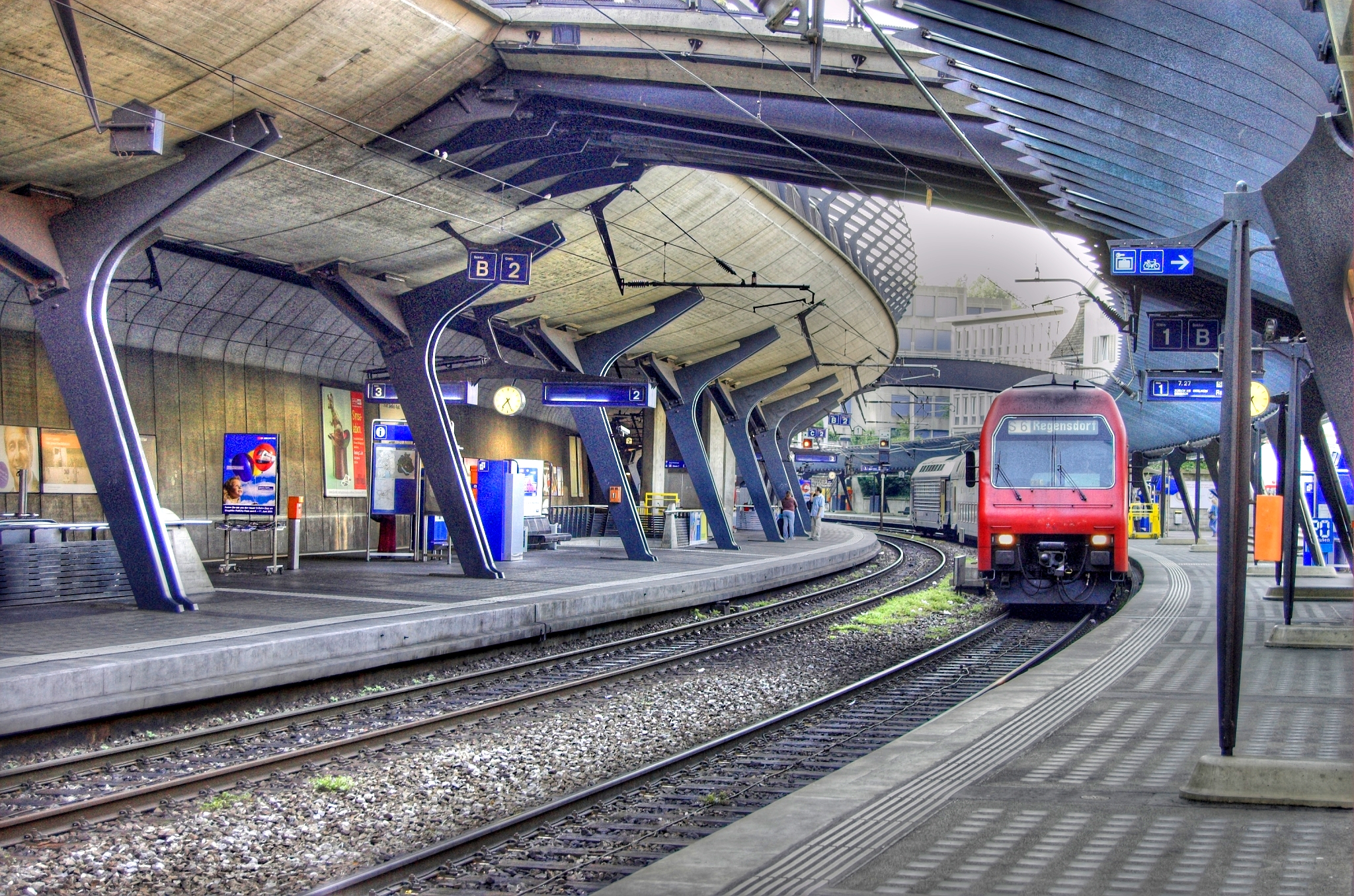
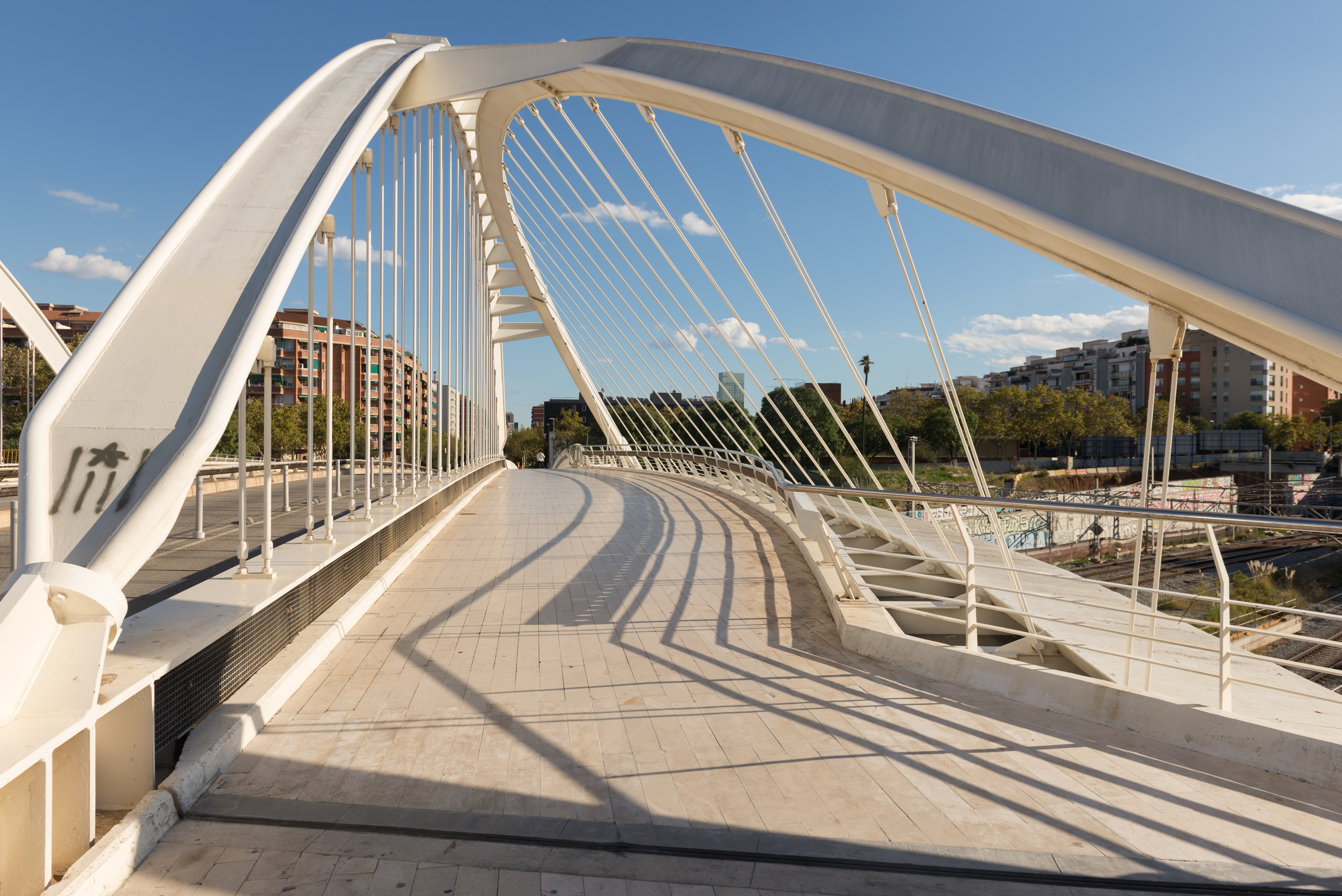
In 1984-87, Calatrava built his first bridge, the Bac de Roda Bridge in Barcelona, Spain, which brought him international recognition. This 420 ft (128 m) long bridge, designed for cyclists and pedestrians, connects two parts of the city over railway tracks. Its twin arches lean at a thirty-degree angle, a feature that quickly became a stylistic signature. The bridge's steel arches and cables form a light, airy network, anchored to massive concrete supports and granite pillars.
His reputation was further solidified by the Puente del Alamillo (1987-1992) in Seville, Spain, built for Seville Expo '92. This 656 ft (200 m) long bridge crosses the Meandro San Jeronimo River and is notable for its single, 466 ft (142 m) high pylon leaning at 58 degrees, the same angle as the Great Pyramid of Giza. The pylon's concrete weight supports the bridge with just thirteen pairs of cables, eliminating the need for rear cables. Other early bridges include the Lusitania Bridge in Mérida, Spain (1988-91).
2.2. Major Projects of the 1990s
The 1990s saw Calatrava expand his portfolio beyond bridges and railway stations to include a wider range of structures, establishing him as a versatile international architect.
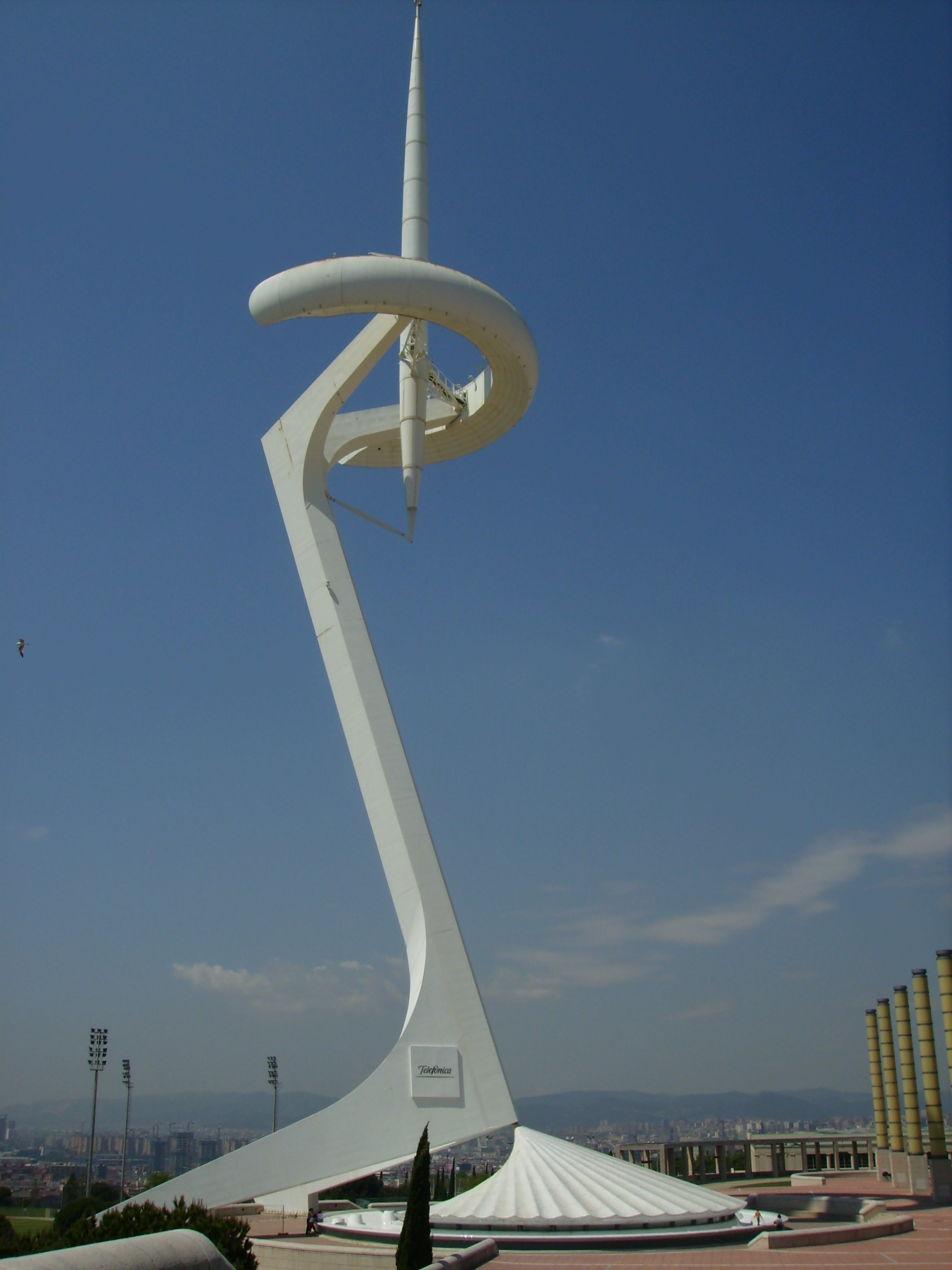
One of his most picturesque and sculptural works, the Montjuïc Communications Tower in Barcelona (1989-92), was completed for the 1992 Summer Olympics. This 446 ft (136 m)-high concrete spire features a backward-leaning pylon that appears to grasp vertical broadcast antennas, suggesting an athlete preparing to throw a javelin. The circular base, clad in white bricks, houses broadcast equipment and includes a metal element resembling an eye that opens and closes. The tower incorporates colorful ceramic tiles, a nod to Antoni Gaudí's Park Güell, and casts its shadow on an adjacent square designed as a giant sundial.
In 1992, Calatrava completed his first North American project, the Allen Lambert Galleria within Brookfield Place (Toronto) in Toronto, Ontario, Canada. The shopping mall's interior is covered by a glass roof supported by gigantic tree-like columns, reminiscent of the Belle Époque Les Halles market in Paris.
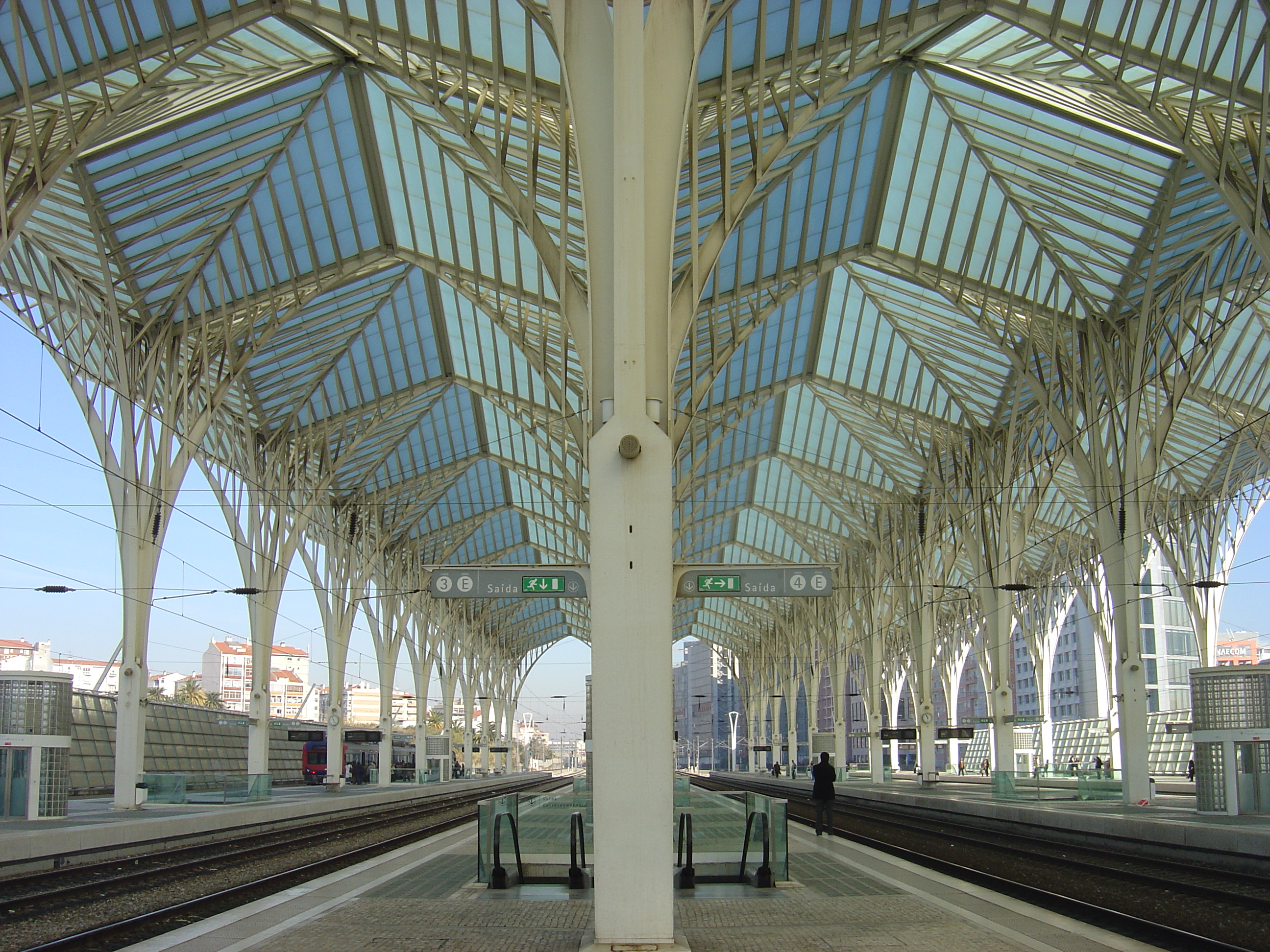
Two significant railway stations from this decade are the Gare de Lyon Saint-Exupéry (1989-1994) at the Lyon airport in Satolas, France, and the Gare do Oriente in Lisbon, Portugal (1992-98). The Lyon-Saint-Exupéry station serves as a functional link between the airport and the high-speed TGV train terminal, also symbolizing the Rhône-Alpes region. It is covered by a 394 ft (120 m) steel and glass shell, suspended at a maximum height of 131 ft (40 m) and weighing 1.30 K t. An 591 ft (180 m) long glass and concrete bridge connects it to the airport terminal. The interior, with its glass and steel sides and skylights, evokes a modern cathedral, while the glass panels are designed to suggest flight. From the exterior, the station has been likened to a prehistoric animal, and its bridge to a bird or a manta ray.
The Gare do Oriente, built for the 1998 Lisbon World Exposition in a former industrial area, was designed to bridge the gap between the city's residential area and the Tagus River. Similar to the Toronto galleria, but on a grander scale, its interior features a "forest" of white columns supporting a 781 ft (238 m) glass roof covering eight tracks. The complex also includes a shopping center and tram/metro links. Its multiple arches and curves give the impression of movement, as if ready for takeoff.
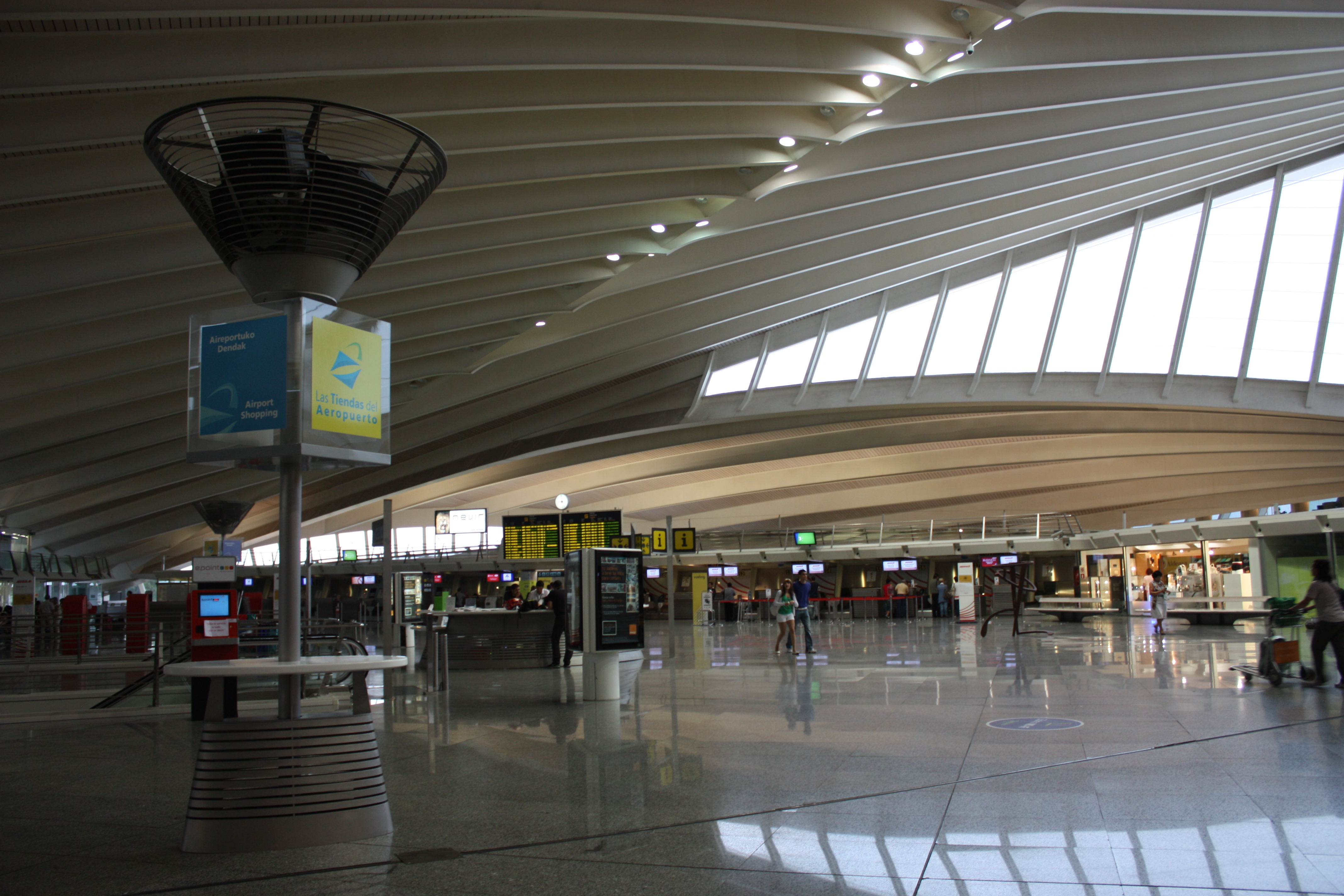
One of Calatrava's late 20th-century projects was the Bilbao Airport in Spain (1990-2000). It is notable for its unusual 138 ft (42 m) high control tower, made of aluminum-clad concrete that widens as it rises, resembling a statue with hands held in front. The terminal buildings feature white concrete structures united with aluminum forms, appearing to lift upwards as if preparing for flight, earning the airport the popular nickname "The Dove." Other completed works of this period include the Llonja de Sant Jordi in Alcoy (1992-95), the Trinity Bridge in Manchester (1995), and the renovation of the Oberbaum Bridge in Berlin (1991-96).
2.3. Major Projects of the 2000s
The 2000s saw Calatrava complete several major projects, including museums, concert halls, and his first twisting skyscraper, further solidifying his global presence.
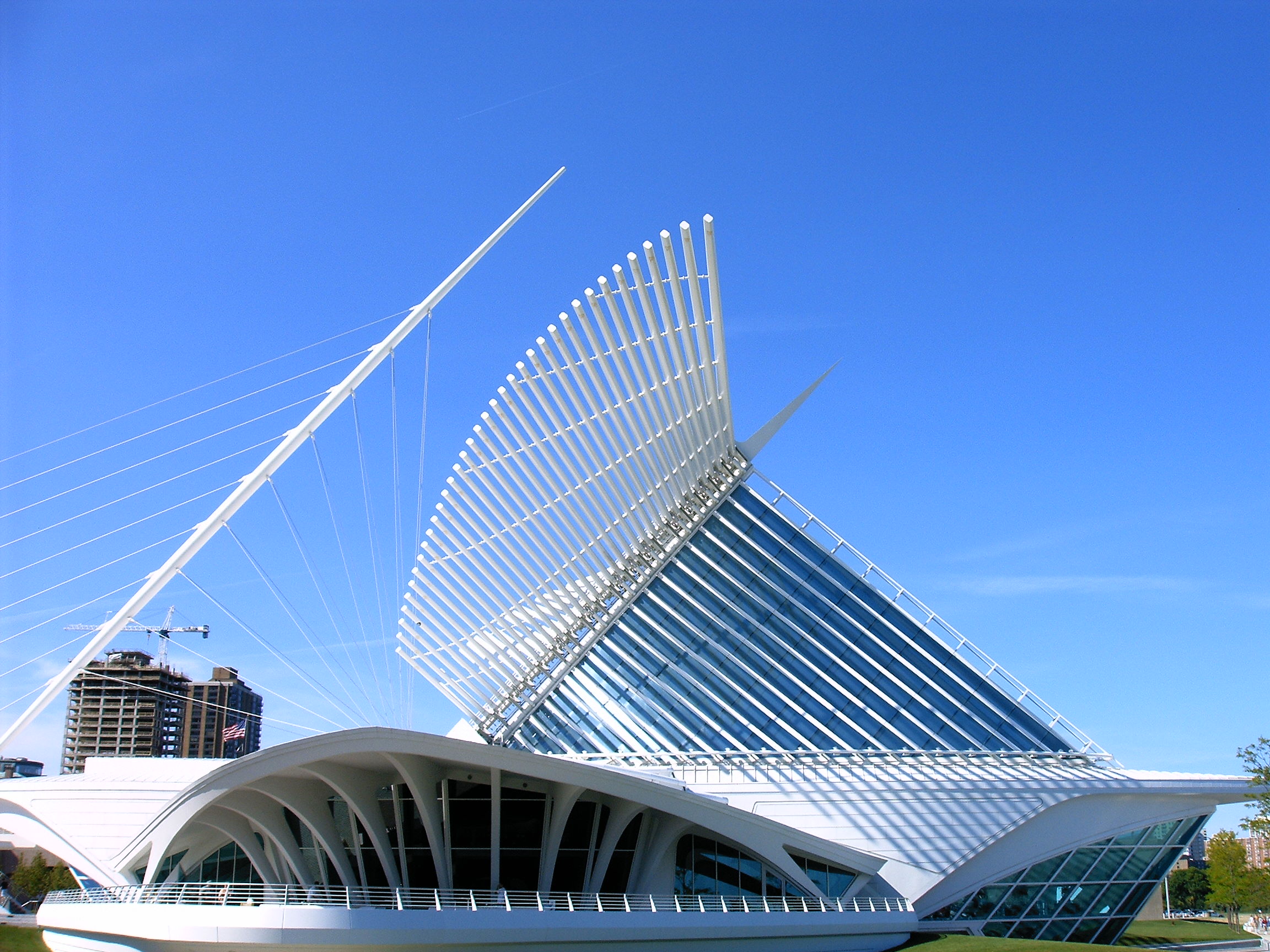
The Quadracci Pavilion of the Milwaukee Art Museum (1994-2001) was Calatrava's first building in the United States and his first museum. It displayed the technical innovations and forms he had first used in his railway stations and airports, but with more freedom of form and architectural theatrics. It is an addition to an existing building, constructed by Eero Saarinen in 1957 next to Lake Michigan, with a later addition in 1975 by David Kahler. The purpose of the new pavilion, as defined by the museum board, was to give the museum a new entrance, and especially "to redefine the identity of the museum with a strong image." Calatrava's design was selected after a competition entered by seventy-seven architects. Calatrava's solution was a glass and steel entry hall 6.6 ft (2 m) high with a moveable sun screen roof, composed of twenty-six smaller wings, ranging from 26 ft (8 m) to 105 ft (32 m) in length, forming two large wings. Weighing 115 t, the sunscreen can be hoisted by a single pylon, like an enormous bird's wing, or lowered when winds from the lake exceed 40 mph (65 km/h). The interior of the structure has a conference hall, exposition space, shops, and a restaurant overlooking the lake. He also designed a suspension footbridge between the center of the city and edge of the lake.
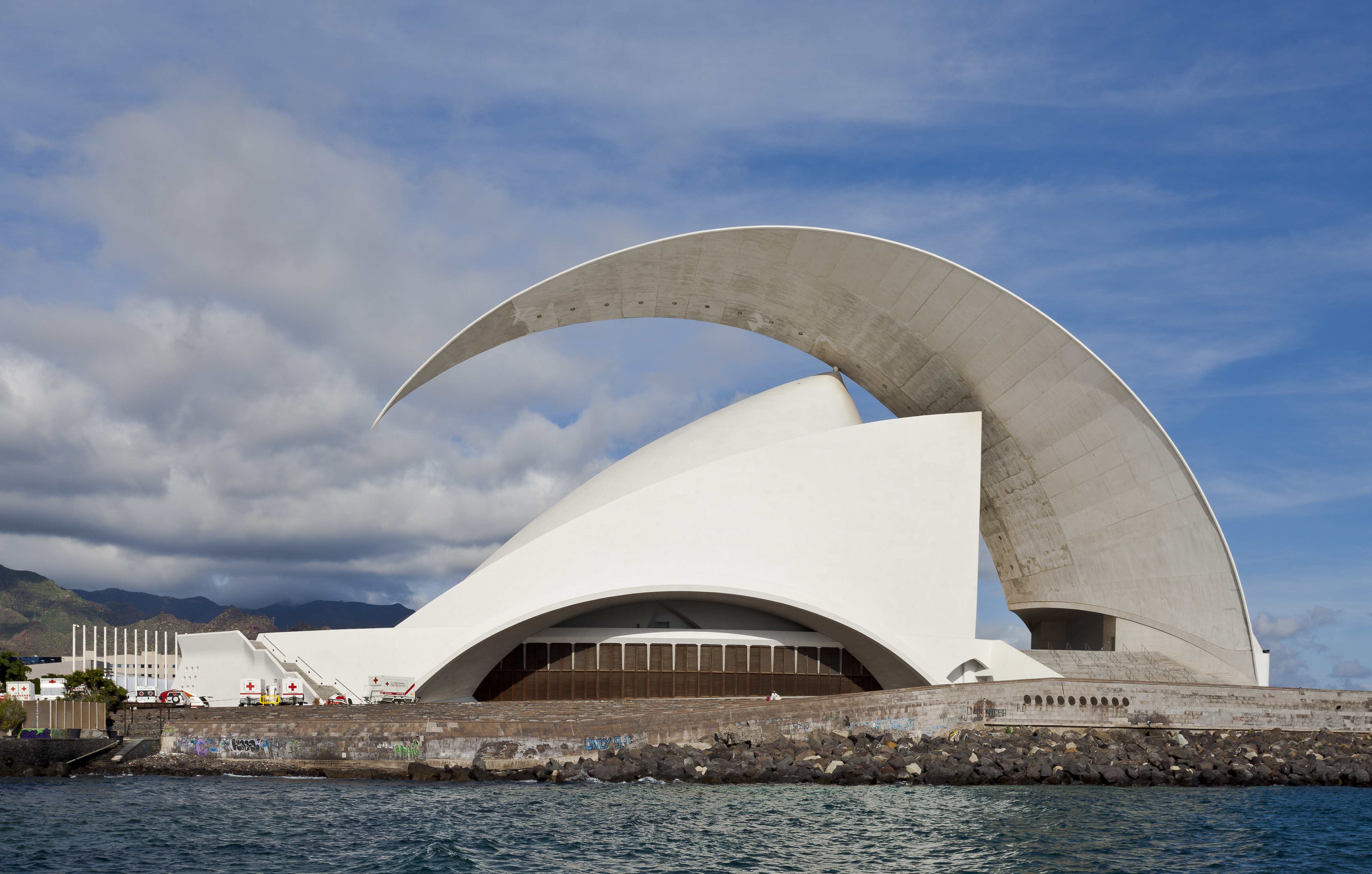
The Bodegas Ysios winery in Laguardia, Spain (1998-2001), was designed as a symbol for Rioja wines. Built on a sloping vineyard site, the 643 ft (196 m) long building features an aluminum roof and a facade of alternating convex and concave laminated wood panels, with a roofline that ripples like waves.
The Auditorio de Tenerife in Santa Cruz de Tenerife, Tenerife, Canary Islands (1991-2003), is a concert hall with 1558 seats and a smaller 428-seat chamber music hall. With a curving concrete cupola 197 ft (60 m) high, crowned by a curving roof like a breaking wave, it dominates the city square and old town below. The shell is covered with ceramic tiles and the pavement and most of the floors are made of the local basalt stone. The unusual sculptural form of the building gives it a completely different appearance depending upon from where it is viewed.
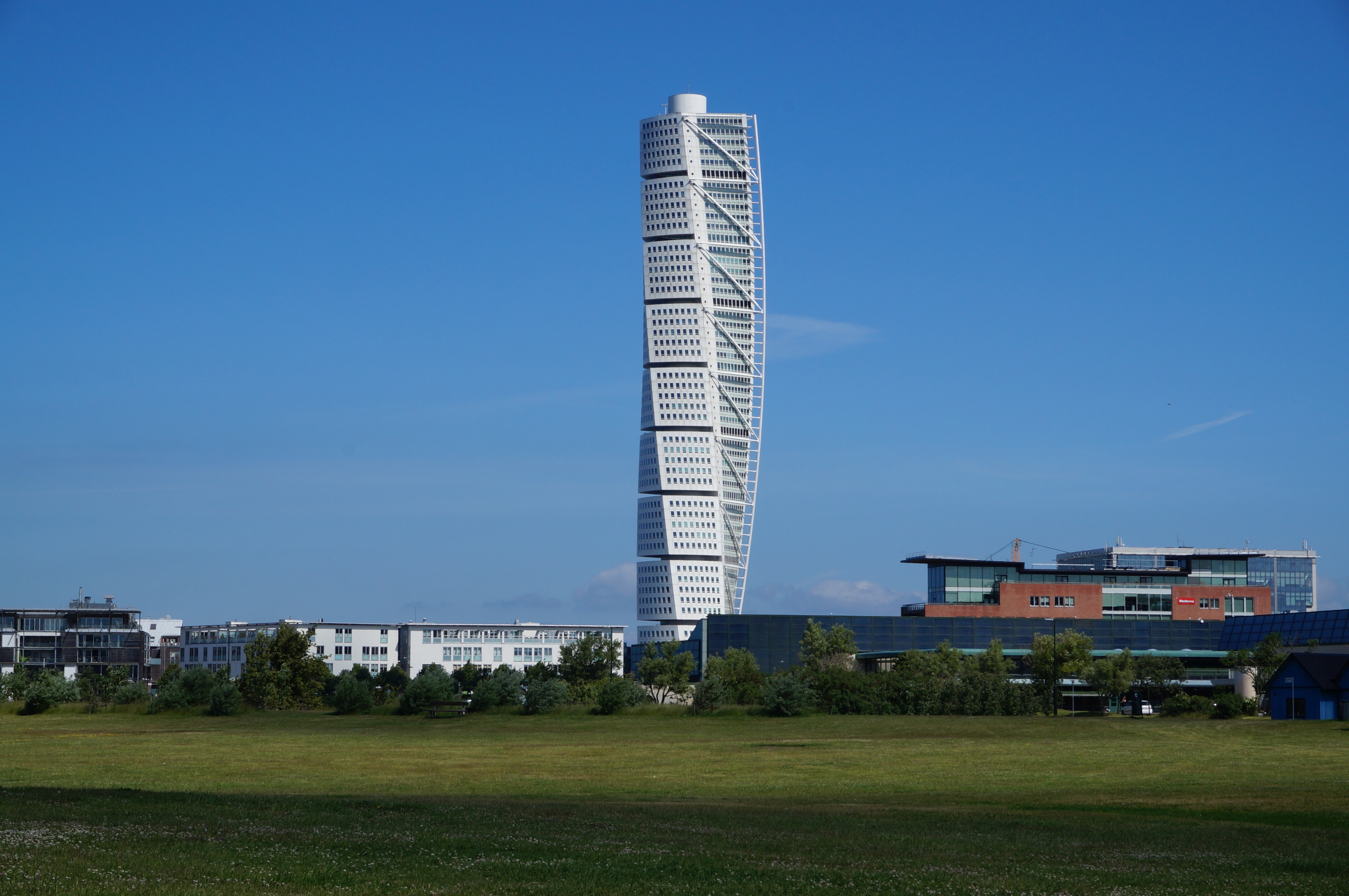
The Turning Torso in Malmö, Sweden (1999-2004), was Calatrava's first skyscraper, and was the first twisting skyscraper, a form which later appeared in other cities around the world from Shanghai to Moscow. The building was originally conceived by the architect as a sculpture of "seven cubes stacked on a steel support creating a spiral structure resembling a twisting spinal column." The tower is 623 ft (190 m) high, and twists a full ninety degrees from the base to the top. Each of the nine cubes is like a separate five-story building; each floor contains from one to five apartments. The support holding the structure together is the column of elevators and escalators which communicate between the cubes. A system of discreet cross beams on the exterior frame manage the torsion of the twisting building. In 2016, it was the tallest building in Scandinavia.
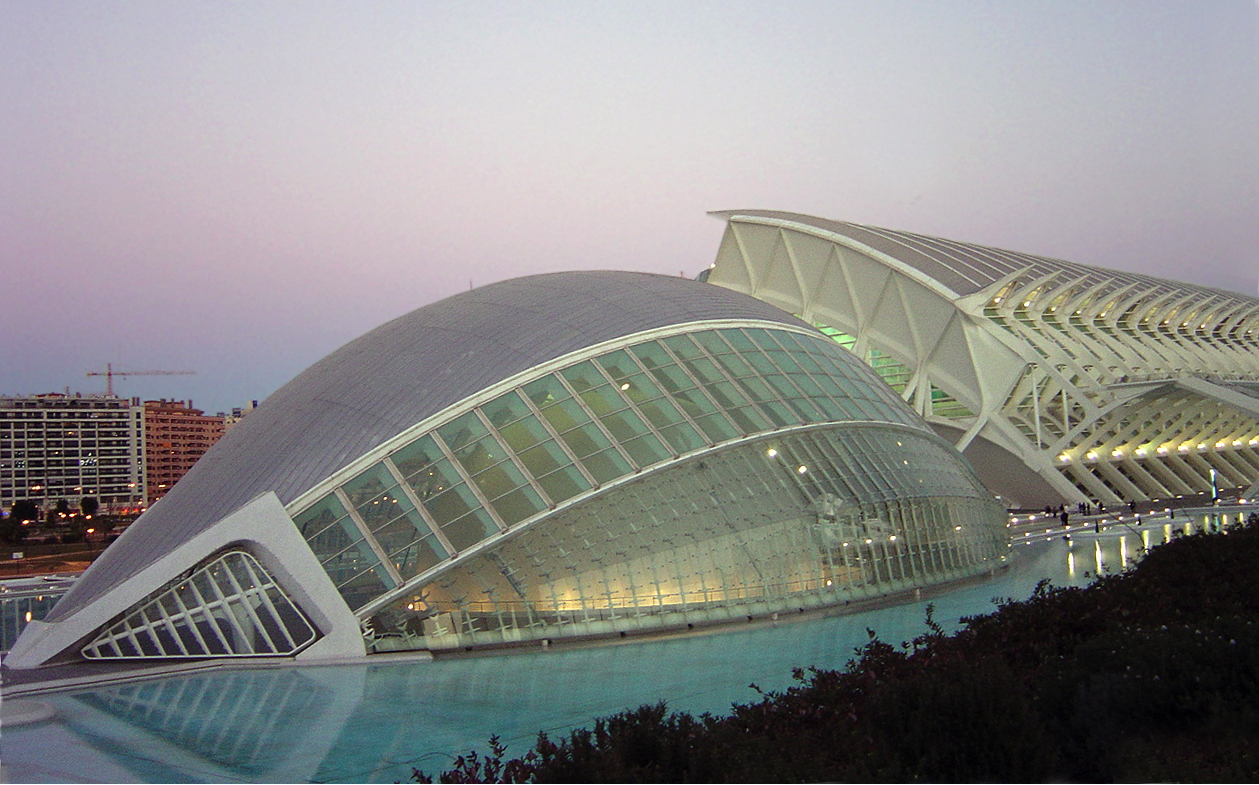
For the 2004 Olympic Games in Athens, Greece, Calatrava won the commission to cover the existing stadium with a new roof, to make a similar roof for the velodrome, and additionally to build four entrance gateways, a monumental sculpture to symbolize the games, and other architectural features to give harmony and variety to the complex. The roof for the stadium, in the form of bent "leaves" of laminated glass, is designed to reflect 90 percent of the sunlight. The roof covers 269 K ft2 (25.00 K m2), and is supported by double-tied arches of tubular steel, with a span of 997 ft (304 m) and a height of 197 ft (60 m). The velodrome has a white cap supported by two concrete arches 148 ft (45 m) high, weighing 4.00 K t, from which the glass and steel roof is suspended. Calatrava also designed an enormous parabolic arch at the entrance and the Wall of Nations, a mobile sculpture of tubular steel which moves in a wavelike patterns.
The largest group of buildings by Calatrava is found in his birthplace, Valencia, Spain, and was built in over a decade. It includes the City of Arts and Sciences (1991-2000) and the Opera house (1996-2006), all constructed on a plot of 86 acre (35 ha) between a highway and a river on the east side of the city. The L'Hemisfèric, like a half-sunken globe, is placed in the centre, next to a large artificial lake, in which it seems to be sinking. The dome is covered by a metal screen which opens and closes, and the entrance opens like a human eye. On one side is the science museum, behind a line of leaning columns, and on the other is the newest structure, the massive shell of the opera house, described by Calatrava as a "monumental sculpture", which gives the impression of being continually in motion.

The Liège-Guillemins railway station for high-speed trains in Liège, Belgium (2009), is covered with a lace-like roof of glass and steel 525 ft (160 m) long and 105 ft (32 m) high, covering the nine tracks and five platforms. The transparent roof seems to eliminate the distinction between indoors and outdoors.
2.4. Major Projects Since the 2010s
Since 2010, Calatrava has continued to deliver significant architectural and engineering achievements globally, including bridges, university campuses, and cultural institutions.
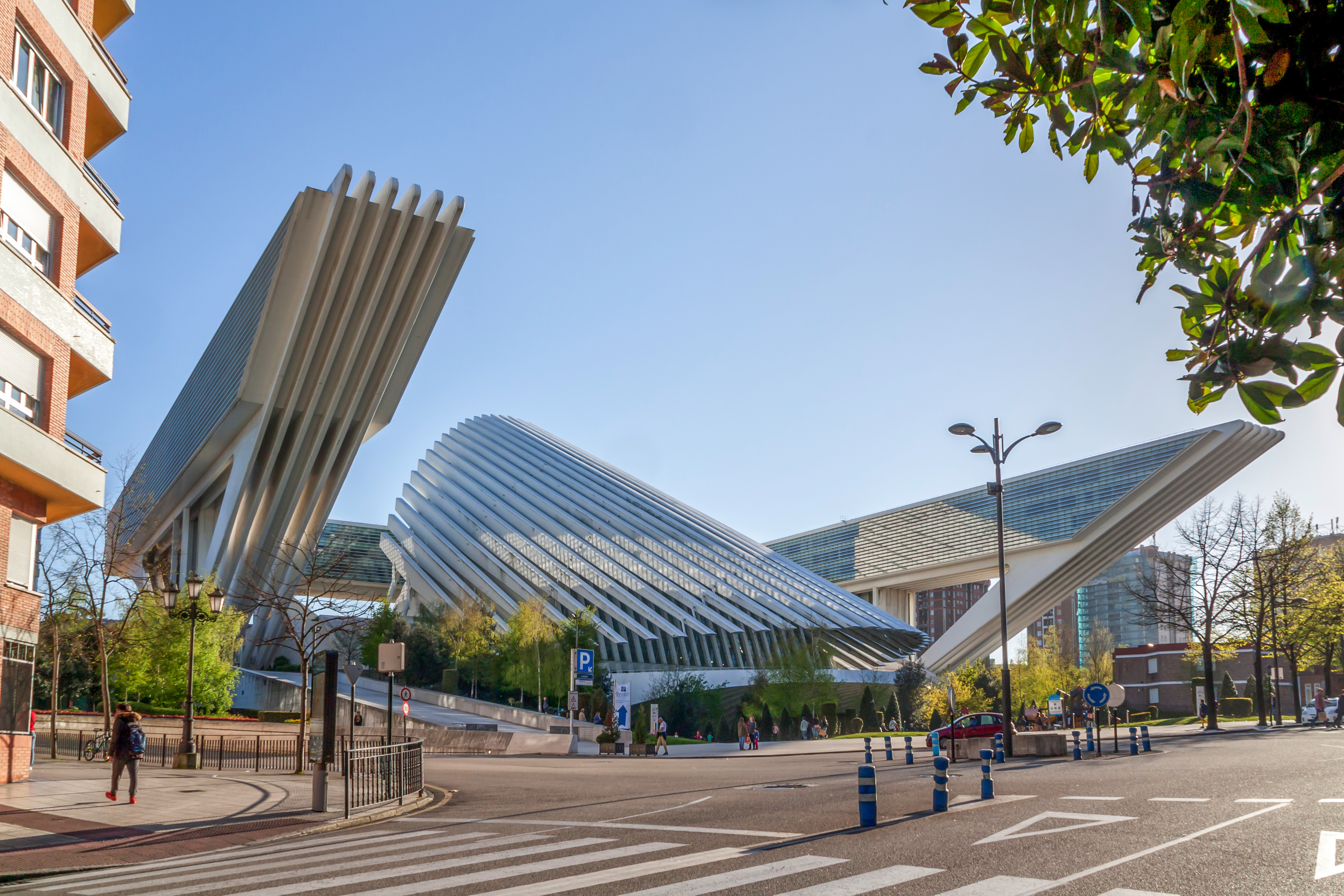
The conference center and exposition hall in the Spanish city of Oviedo (2000-2011) combines two office buildings and a hotel, covered with horizontal bands of glass and steel and perched upon curving concrete pylons, with elliptical conference center, which includes a main theater, exposition hall and seminar rooms. The Center includes another signature feature of Calatrava's work; a sunscreen that was supposed to be able to fold and unfold, but was never functional. The ceiling of the concert hall is an ascending series of arcs, which echo the curving rows of seats.
Calatrava constructed a series of extraordinary bridges, the type of structure which originally brought him global attention, for cities around the world that wanted a symbol of modernity and daring. Among the largest and dramatic are three bridges over the Trinity River in Dallas, Texas. The first of these was the Margaret Hunt Hill Bridge, opened for traffic in March 2012. The bridge, carrying six lanes of traffic, is 686 ft (209 m) long, with the appearance of being suspended from an arc-shaped tubular steel pylon forty stories or 446 ft (136 m) high by fifty-eight cables, ranging in length from 390 ft (119 m) to 643 ft (196 m). In form, the bridge resembles one of three bridges constructed in 2005-2005 on the Autostrada A1 in Reggio Emilia, Italy. Work on the second bridge, the Margaret McDermott Bridge, began in 2011 and was completed in 2021.
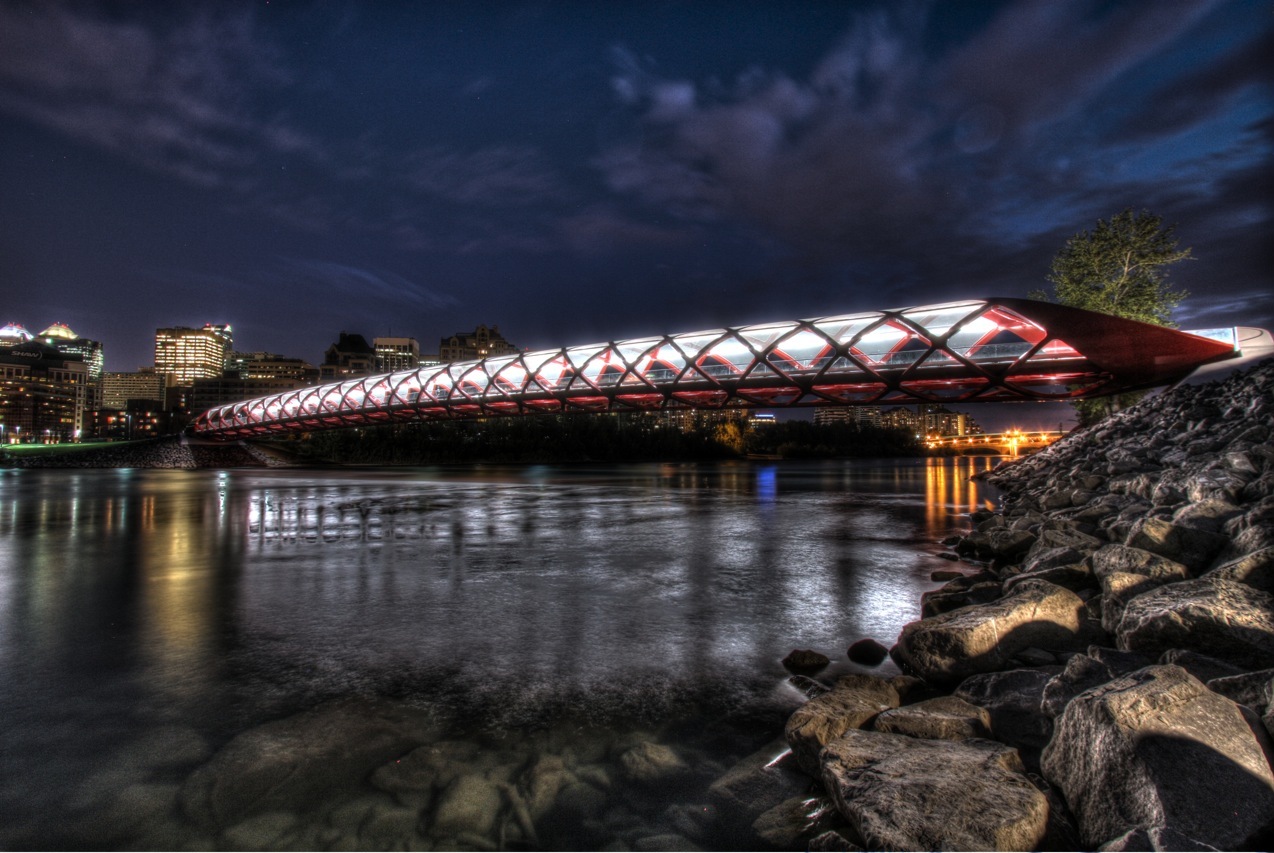
The Peace Bridge in Calgary, Canada, built between 2008 and 2012, is a completely different bridge in purpose, scale and design. Built across the Bow River, and designed for pedestrians and cyclists, it is a glass and steel-wrapped tube 413 ft (126 m) long. It appears extraordinary long for a bridge with no towers or pylons to hold it up. Calatrava described the form in his own particular engineering vocabulary as "defined by a helicoidal movement, with an ovoid cross section, with two clearly materialized tangential lanes expressing an internal architectural volume."
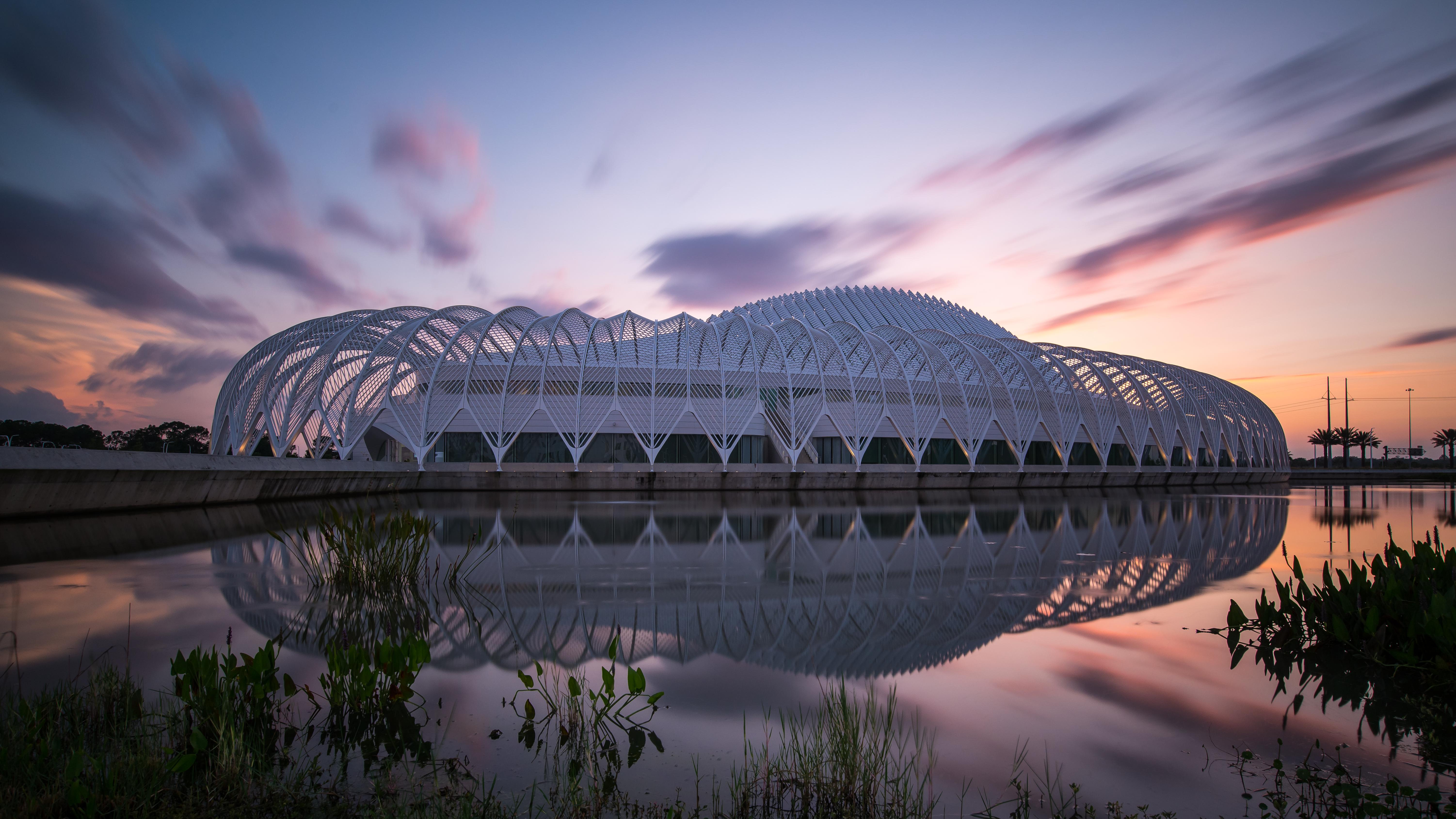
The project for the new Florida Polytechnic University in Lakeland, Florida (2009-2014) gave Calatrava the opportunity to design an entire campus in a unified style. The site covers 170 acre (170 acre) of land which once contained phosphorus mines, many of which have been filled with water creating small lakes. Calatrava's plan combined several small lakes into a central lake, which serves as a setting for the central structure, the Innovation, Science, and Technology (IST) building. The eye-shaped central building has an area of 200.00 K ft2 on two floors, and contains all the classrooms, faculty offices laboratories and public spaces until the other buildings are completed. The building has several signature Calatrava features, including an extendable sun screen on the roof, which entirely changes the appearance of the building when deployed, and whose form changes gradually as the sun moves. The terraces of the building are covered by a curving pergola, or screen, of steel, which reduces the direct sunlight by thirty percent. Inside, the corridors and central courtyard are lit by the central skylight. Plans for the building call for the installation of 20 K ft2 (1.86 K m2) of solar panels on the sunscreen to provide energy for the building. The library of the university is also distinctive; it does not have a single book; all the collection is digitized. This structure has been called by some journalists a response to the criticism of the high price and technical flaws of some of Calatrava's earlier buildings, demonstrating attention to detail and budget.
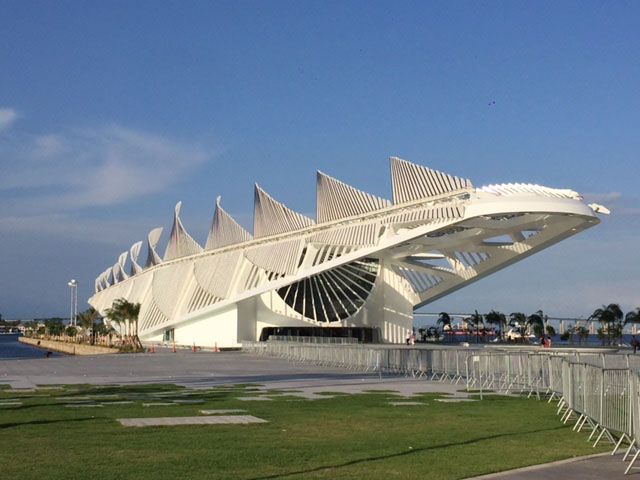
The Museum of Tomorrow in Rio de Janeiro, Brazil, which opened in December 2015, is part of the redevelopment of the waterfront of Rio de Janeiro, and opened in time for the 2016 Summer Olympics in that city. The building is sited on a 82 K ft2 (7.60 K m2) plaza next to the harbor, and surrounded by reflecting pools. The building is cantilevered 246 ft (75 m) over the plaza, and 148 ft (45 m) toward the sea, and gives the impression that it is floating on the water. Calatrava wrote, "The idea is that the building feels ethereal, almost floating on the sea, like a ship, a bird or a plant." The roof is equipped with moveable screens that adjust to the movements of the sun. The interior design is what Calatrava calls "archetypal" and simplified, to allow for exhibits in a greater variety of forms and sizes. The museum also includes a number of ecological features; water from the sea is used to regulate the temperature inside the building, and to refill the surrounding reflecting pools. The Guardian described it as "an other-worldly edifice that looks like a cross between a solar-powered dinosaur and a giant air conditioning unit", and declared "it must already rank as one of the world's most extraordinary buildings."

Calatrava designed the World Trade Center Transportation Hub in New York City (2003-2016) at the rebuilt World Trade Center site at the site of the September 11 attacks in 2001. The new station connects the regional trains of the new PATH with the subway and other local transportation, and also has a large retail mall, replacing commercial space destroyed in the attack. The above-ground "oculus" of the station, made of glass and steel, is oval-shaped, and is 115 ft (35 m) long and 95 ft (29 m) high. According to Calatrava, it resembles "a bird flying from the hands of a child". The "Wings" of the above-ground structure were originally designed to move upward to a maximum height of 167 ft (51 m) to form a double screen, but this feature had to be dropped to meet new security standards. The main hall of the station is 33 ft (10 m) underground, and the tracks of the PATH system on another level 26 ft (8 m) below. The underground station was originally designed so that its roof would open entirely in good weather, but this feature also had to be dropped due to its cost and space limitations.
Other recent completed projects include the San Francesco di Paola Bridge in Cosenza, Italy (2018), the UAE Pavilion at EXPO 2020 in Dubai, UAE (2021), the St. Nicholas Greek Orthodox Church in New York City (2022), and the Mons railway station in Mons, Belgium (2024).
2.5. Architectural Style and Philosophy
Calatrava's architectural style is highly distinctive, characterized by a profound integration of structural engineering principles with organic, sculptural forms, often inspired by nature and the human body. He has never aligned himself with a specific architectural school or movement, stating that critics are often "perplexed" by his work.
His designs frequently feature exposed skeletal frameworks, creating a harmonious interplay of numerous bone-like or winged elements. This results in a strong visual impact underpinned by rigorous structural theory. Many of his structures are clad in white, which, especially at night with lighting, creates a spectacular effect. This preference for white, along with cantilevered forms, aligns with some Spanish and Israeli architectural traditions, but Calatrava's approach remains highly original. He often employs triangular structural forms, connecting them with straight lines, curves, and shell-like elements to create three-dimensional and symbolic buildings.
Movement is a crucial element in Calatrava's architecture. He noted that many 20th century sculptors, such as Alexander Calder, made sculptures that moved. He wrote his own university thesis on "The Flexibility of three-dimensional structures," and described how objects, by moving, could shift from three dimensions to two and even to one. Moving elements which folded and expanded became an important element of almost all of his projects. "Architecture itself moves", he told a biographer, "and, with a little chance, becomes a magnificent ruin".
Calatrava views his architectural work as a synthesis of all arts, frequently discussing the connection between sculpture and architecture. He notes that many of his architectural works, such as the Turning Torso, originated as sculptures. He acknowledges the artistic liberties taken by figures like Frank Gehry and Frank Stella but also notes the differences. In 1997 he wrote that "architecture and sculpture are two rivers in which the same water flows," distinguishing sculpture as a "pure plastic art" while architecture is a "plastic art which is submitted to function, taking into consideration the human scale." Calatrava also noted the influence of the sculptor Auguste Rodin, citing Rodin's words in his 1914 book Cathedrals of France: "The sculptor only achieves the greatness of expression in concentrating his attention on harmonic contrasts of light and shadow, exactly as an architect does."
2.6. Artistic Activities
Beyond his renowned architectural and engineering work, Santiago Calatrava is also an accomplished sculptor and painter. Many of his architectural designs, most notably the Turning Torso skyscraper in Malmö, Sweden, were initially conceived as works of sculpture, demonstrating the deep connection between his artistic and architectural practices.
Calatrava's artistic endeavors have been showcased in prestigious institutions worldwide. In 2006, the Metropolitan Museum of Art in New York City hosted a solo exhibition titled Santiago Calatrava: Sculpture Into Architecture, featuring his drawings, sculptures, and architectural models. This exhibition highlighted how his sculptural ideas translate into his architectural forms.
His artworks have continued to be exhibited internationally. In 2012, the Hermitage Museum in Saint Petersburg held an exhibition of his work, followed by another at the Vatican Museum in Rome in 2013. In the spring of 2015, eight of his sculptures were displayed along Park Avenue in New York City, between 52nd and 55th Streets, making his art accessible to a wider public. In 2024, Nick Mafi published "Calatrava: Art," the first comprehensive overview of Calatrava's artistic output.
2.7. List of Major Works
This section provides a comprehensive catalog of Santiago Calatrava's significant projects, including completed, proposed, and abandoned works, showcasing the breadth and evolution of his portfolio.
| Name | Year | Location | Country | Notes |
|---|---|---|---|---|
| Jakem Steel Warehouse | 1983-84 | Munchwilen | Switzerland | |
| Ernsting Warehouse | 1983-85 | Coesfeld | Germany | |
| Wohlen High School | 1983-88 | Wohlen | Switzerland | |
| Stadelhofen Railway Station | 1983-90 | Zurich | Switzerland | |
| Hall of Lucerne railway station | 1983-89 | Lucerne | Switzerland | |
| Bac de Roda Bridge | 1984-87 | Barcelona | Spain | |
| Barenmatte Community Center | 1984-88 | Suhr | Switzerland | |
| Tabourettli Theater | 1986-87 | Basel | Switzerland | |
| 9 De Octubre Bridge | 1986-88 | Valencia | Spain | |
| Allen Lambert Galleria (in Brookfield Place) | 1987-92 | Toronto | Canada | |
| Buchen Housing Estate | 1987-96 | Würenlingen | Switzerland | |
| Emergency Services Centre | 1989-98 | St. Gallen | Switzerland | |
| Lyon-Saint-Exupéry TGV Station | 1989-94 | Lyon | France | |
| La Devesa Footbridge | 1989-91 | Ripoll | Spain | |
| Puerto Bridge | 1989-95 | Ondarroa | Spain | |
| Bohl Bus and Tram stop | 1989-96 | St. Gallen | Switzerland | |
| Alameda Bridge and Metro Station | 1991-95 | Valencia | Spain | Steel structure |
| Oberbaum Bridge Renovation | 1991-96 | Berlin | Germany | |
| Alamillo Bridge | 1992 | Seville | Spain | |
| Lusitania Bridge | 1992 | Mérida | Spain | |
| Montjuic Communications Tower | 1992 | Barcelona | Spain | At the Olympic Ring |
| World's Fair, Kuwaiti Pavilion | 1992 | Seville | Spain | |
| Mimico Creek Bridge | 1994 | Humber Bay Park, Toronto | Canada | |
| Kronprinzenbrücke | 1994 | Berlin | Germany | |
| Campo Volantin Footbridge | 1994-97 | Bilbao | Spain | |
| Llonja de Sant Jordi | 1992-95 | Alcoy (Alicante) | Spain | |
| Trinity Bridge | 1995 | Manchester and Salford | England | Footbridge over River Irwell |
| City of Arts and Sciences | 1996-2009 | Valencia | Spain | |
| Centro Internacional de Ferias y Congresos de Tenerife | 1996 | Santa Cruz de Tenerife | Spain | |
| Pont de l'Europe | 1996-2000 | Orléans | France | |
| Pfalzkeller Gallery | 1997 | St. Gallen | Switzerland | |
| Gare do Oriente | 1998 | Lisbon | Portugal | |
| Puente de la Mujer | 1998 | Buenos Aires | Argentina | |
| New York Times Capsule | 1999 | U.S.A. | United States | |
| Puente del Hospital | 1999 | Murcia | Spain | |
| New terminal at Bilbao Airport | 2000 | Bilbao | Spain | |
| Milwaukee Art Museum | 2001 | Milwaukee | United States | |
| Bodegas Ysios | 2001 | Laguardia | Spain | |
| Wave | 2002 | Dallas | United States | At the Southern Methodist University Meadows Museum |
| James Joyce Bridge | 2003 | Dublin | Ireland | Bridge over River Liffey |
| Auditorio de Tenerife | 2003 | Santa Cruz de Tenerife | Spain | First performing arts facility |
| redesign of Athens Olympic Sports Complex | 2004 | Athens | Greece | |
| Katehaki Footbridge | 2004 | Athens | Greece | |
| Sundial Bridge at Turtle Bay | 2004 | Redding | United States | |
| Three bridges (Harp, Cittern and Lute) | 2004 | Haarlemmermeer | Netherlands | Spanning the main canal |
| University of Zurich, "Bibliothekseinbau" library remodelling | 2004 | Zurich | Switzerland | |
| Bridge connecting Avnat shopping mall and Rabin Medical Center | 2005 | Petah Tikva | Israel | |
| Turning Torso | 2005 | Malmö | Sweden | |
| Three bridges on the A1 Motorway and Milan-Bologna high-speed railway | 2007 | Reggio Emilia | Italy | |
| Chords Bridge | 2008 | Jerusalem | Israel | Light rail bridge at the entrance |
| Ponte della Costituzione footbridge | 2008 | Venice | Italy | From Piazzale Roma over the Grand Canal |
| Technion Obelisk | 2008-2009 | Haifa | Israel | Monument on the Technion campus |
| Liège-Guillemins railway station | 2009 | Liège | Belgium | |
| Samuel Beckett Bridge | 2009 | Dublin | Ireland | Bridge over River Liffey |
| Caja Madrid Obelisk | 2009 | Madrid | Spain | |
| Palacio de Congresos de Oviedo | 2011 | Oviedo | Spain | Conference Center |
| Palacio de Exposiciones y Congresos | 2011 | Oviedo | Spain | |
| Margaret Hunt Hill Bridge | 2012 | Dallas, Texas | United States | |
| Peace Bridge | 2012 | Calgary, Alberta | Canada | |
| Medio Padana Station | 2013 | Reggio Emilia | Italy | On the Milan-Bologna high-speed railway |
| Florida Polytechnic University | 2014 | Lakeland, Florida | United States | |
| Museu do Amanhã | 2015 | Rio de Janeiro | Brazil | |
| World Trade Center Transportation Hub | 2016 | New York City | United States | |
| San Francesco di Paola Bridge | 2018 | Cosenza | Italy | |
| Margaret McDermott Bridge | 2021 | Dallas, Texas | United States | |
| UAE Pavilion at EXPO 2020 | 2021 | Dubai | UAE | |
| St. Nicholas Greek Orthodox Church | 2022 | New York City | United States | |
| Mons railway station | 2024 | Mons | Belgium |
- Under construction/proposed:**
- City of Sport, University of Rome Tor Vergata, Italy
- Peninsula Place, Greenwich, London (a 1.00 B USD project for three towers and a footbridge)
- Sharq Crossing, Doha, Qatar: a project for three bridges and two tunnels (postponed until after 2022)
- Dubai Creek Tower, Dubai, UAE (ground broken, scheduled for completion in 2025; in competition for world's tallest structure)
- Yuan Ze University Building (Taoyuan International Conference Center), Taoyuan, Taiwan.
- Atlanta Symphony Center, Atlanta, Georgia, U.S.
- Maastricht University (campus), Maastricht, Netherlands
- Palma de Mallorca Opera House, Spain
- High-rise building in the middle of the Liffey River, Dublin, Ireland
- New railway station and two bridges at Denver International Airport, U.S.
- Abandoned:**
- Chicago Spire, Chicago, Illinois, United States (planned as the tallest building in North America at 2001 ft (610 m) or 2.00 K ft, expected completion 2012)
- Fordham Spire, Chicago, Illinois, United States (planned as 115-story tower)
3. Awards and Recognition
Santiago Calatrava has received numerous prestigious awards, honorary degrees, and other accolades throughout his career, recognizing his significant contributions to architecture and engineering.
3.1. Major Awards
Calatrava's distinguished career has been marked by several key honors from leading architectural and engineering institutions. In 1988, he was awarded the Fazlur Khan International Fellowship by the SOM Foundation. He received the "Médaille d'Argent de la Recherche et de la Technique" in Paris in 1990. In 1992, he was honored with the prestigious Gold Medal of the Institution of Structural Engineers from London. The Museum of Modern Art in New York held a major exhibition of his work, "Structure and Expression," in 1993. In 1996, he received the Gold Medal for Fine Arts from the Spanish Ministry of Culture in Granada. He was elected a member of "Les Arts et Lettres" in Paris in 1998.
In 1999, Calatrava received the Prince of Asturias Award for the Arts, a highly esteemed Spanish honor. The American Institute of Architects (AIA) awarded him their Gold Medal in 2005. In 2000, he received the Algur H. Meadows Award from the Meadows School of the Arts at Southern Methodist University. The Council for the Arts of MIT presented him with the Eugene McDermott Award in 2006, a significant recognition in American arts. He was also appointed a Global Leader for Tomorrow by the World Economic Forum in Davos in 2006. In 2007, he received the Spanish National Architecture Award. In 2004, Calatrava was a recipient of the Golden Plate Award of the American Academy of Achievement, presented by Awards Council member Quincy Jones during the International Achievement Summit in Chicago. He also received the James Parks Morton Interfaith Award in 2004. He is a Senior Fellow of the Design Futures Council.
3.2. Honorary Degrees and Memberships
Calatrava has been recognized with a total of twenty-two honorary degrees from universities worldwide, acknowledging his profound impact on design and engineering. He received honorary degrees from:
- Universidad Politecnica de Valencia (1993)
- Heriot-Watt University (1994)
- University of Seville (1994)
- University of Salford (1995)
- University of Strathclyde (1996)
- Milwaukee School of Engineering (1997)
- Delft University of Technology (1997)
- University of Cassino (1999)
- Lund University (1999)
- Universita degli Studi di Ferrara (1999)
- Technion - Israel Institute of Technology (2004)
- Southern Methodist University (2005)
- Aristotle University of Thessaloniki (2005)
- Rensselaer Polytechnic Institute (2006)
- Columbia University (2007)
- Tel Aviv University (2008)
- Oxford University (2009)
- University Camilo Jose Cela (2009)
- Universite de Liège (2010)
- Pratt Institute (2012)
- Georgia Institute of Technology (2013)
- Instituto Politécnico Nacional (IPN) in México (2016)
In addition to his honorary degrees, Calatrava was appointed a member of the Pontifical Council for Culture by Pope Benedict XVI on 10 December 2011, for a five-year renewable term.
4. Criticism and Controversy
Despite widespread acclaim for his innovative designs, Santiago Calatrava's projects have drawn significant criticism and controversy, primarily concerning cost overruns, construction delays, and functional issues.
4.1. Cost Overruns and Schedule Delays
A recurring criticism of Calatrava's projects is their tendency to significantly exceed original budgets and timelines. A 2013 New York Times article titled "Santiago Calatrava collects critics as well as fans" highlighted that it is "hard to find a Calatrava project that has not been significantly over budget." For instance, a Dutch councilor in Haarlemmermeer urged legal action because three bridges designed by Calatrava for the town cost twice the budgeted amount and incurred millions more in upkeep since their 2004 opening.
The City of Arts and Sciences in Valencia, Spain, originally budgeted for approximately 405.00 M USD, faced accusations of spending nearly three times the initial budget. Ignacio Blanco, an opposition party leader in Valencia, claimed Calatrava was paid around 127.00 M USD for his work on the complex, which initially lacked elevators for disabled access and had 150 seats in the opera house with obstructed views. While Calatrava successfully sued a critic for defamation in 2014, the judge acknowledged that the website's content presented "objective truths" but deemed its name, "Calatrava te la clava" (a rhyme meaning "Calatrava bleeds you dry"), "insulting and degrading." The Venice bridge project, started in 1996, experienced repeated structural design changes to reduce weight, leading to significant delays and a threefold increase in budget by 2007, with eight different engineering consultants involved over a decade. The project was completed in August 2008, but Calatrava was later condemned in court and fined for repair costs related to the bridge.
4.2. Design and Functional Issues
Critics have also raised concerns about the practicality, maintenance, material durability, and overall functionality of some of Calatrava's signature designs. The glass tiles on the floor of his bridge in Bilbao became slippery in the rain, leading to an increase in injury claims and necessitating the installation of a black anti-slip carpet, which obscured the view of the river. Metal arches over some landscaped gardens overheated in the sun, damaging the vines intended to grow on them.
The aluminum and wood covering of the Bodegas Ysios winery in Spain leaked, affecting winemaking operations and requiring extensive repairs. The ceramic tiles (trencadísCatalan) on the surface of the opera house in Valencia, intended as a tribute to Antoni Gaudí, buckled in the heat because concrete and ceramics expand and contract at different rates. Similarly, the tiles on the Auditorio de Tenerife have buckled and lost adhesion, with repairs delayed by disputes between Calatrava's studio and the building companies. The Caja Madrid Obelisk, a kinetic sculpture designed with an undulating movement, has remained static since months after its 2010 inauguration due to high maintenance costs.
In October 2023, the Greek government decided to close the Athens Olympic Stadium and Velodrome, both featuring roofs designed by Calatrava, due to structural stability issues posing a threat to attendees and workers.
4.3. Controversies Related to Specific Projects
The World Trade Center Transportation Hub in New York City became a focal point of controversy due to its exorbitant cost and significant delays. Completed in 2016 for 4.00 B USD, it was twice the original estimate and seven years behind schedule, making it the most expensive railway station ever built. Calatrava received a fee of 80.00 M USD. While some additional costs and delays were attributed to modifications by the project owners, the Port Authority of New York and New Jersey, such as scaling back the original entry pavilion for security reasons and eliminating the mechanism for opening the roof due to budget and space constraints, the project still drew heavy criticism.
Even before it opened the station was a target of criticism: the New York Post described the station in 2014 as it was being built as "a self-indulgent monstrosity" and "a hideous waste of public money". Michael Kimmelman, architecture critic for The New York Times, praised the soaring upward view inside the Oculus, but condemned the building's cost, "scale, monotony of materials and color, preening formalism and disregard for the gritty urban fabric." He also referred to the structure as "a kitsch stegosaurus." New York magazine referred to it in 2015 as it neared completion as a "Glorious Boondoggle". The New York Post editorial board also described the station when it opened in 2016 as the "world's most obscenely overpriced commuter rail station - and possibly its ugliest," comparing the Oculus to a "giant gray-white space insect."
However, the Hub also had its defenders. Jimmy Stamp of The Guardian wrote: "I despised the new World Trade Center transportation hub before I even saw it. It's $2bn over budget, has suffered from construction problems and design compromises, it's seven years late and still incomplete, and its architect, Santiago Calatrava, has left a trail of lawsuits and angry clients around the world....But when I was standing on the marble floors in its enormous, gleaming central concourse two stories below street level, staring up at a clear blue sky between bone-white ribs vaulting 160ft over my head, I, like Jonah in the whale, repented - at least for the moment....We deserve grand expressions of our artistic and technological capabilities. We deserve public spaces that inspire. The Oculus is deeply flawed, but I appreciate its aspiration and grandeur.... The Oculus presents a more optimistic vision, one based less on present realities and more on future possibilities. Less Blade Runner, more Star Trek. By the time we get to that future, whichever one it may be, the delays and the cost and the controversies will be forgotten, but we will be left with a luminous great hall in the heart of downtown New York."
5. Personal Life
Santiago Calatrava maintains residences in both Zurich, Switzerland, and New York City, United States. His family includes three children. Two of his sons have pursued advanced degrees in engineering from the Fu Foundation School of Engineering and Applied Science at Columbia University in New York City. His other son obtained a law degree from Columbia University and practices at the law firm Kirkland & Ellis LLP in Chicago, Illinois. Calatrava also has a daughter who completed advanced degrees in computer science and data analytics, also from Columbia University in New York City.

















